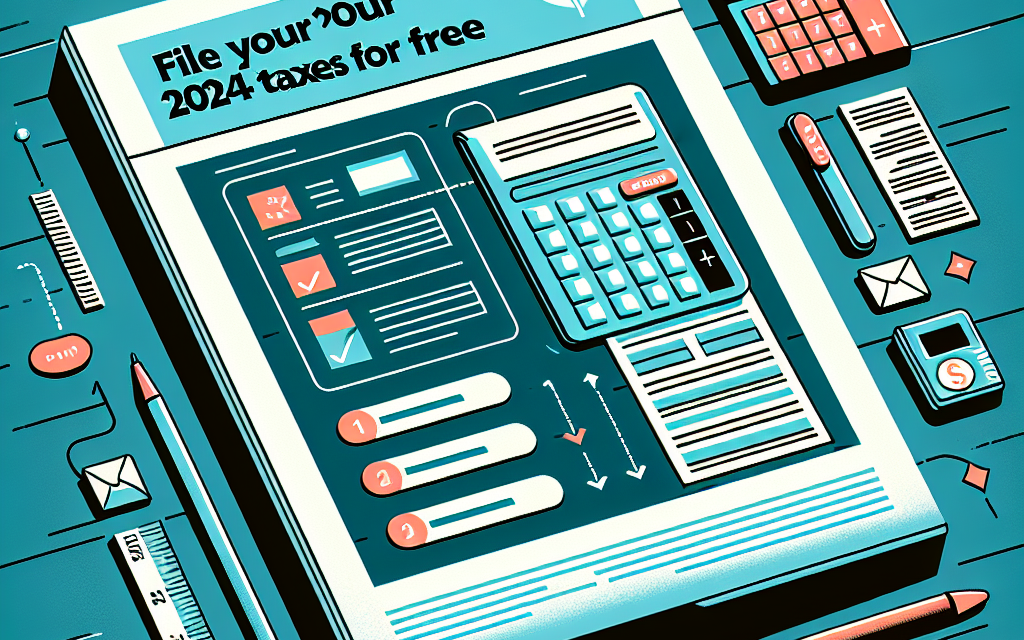“Maximize Your Refund: File Your 2024 Taxes for Free with Our Easy Step-by-Step Guide!”
Introduction
Filing your taxes can often feel overwhelming, but it doesn’t have to be. With the right resources and guidance, you can file your 2024 taxes for free and ensure that you maximize your deductions and credits. This step-by-step guide will walk you through the entire process, from gathering necessary documents to submitting your return. Whether you’re a first-time filer or a seasoned taxpayer, this guide will provide you with the tools and knowledge needed to navigate the tax filing landscape with confidence and ease. Save money and time by taking advantage of free filing options available to you this tax season.
Understanding Free Tax Filing Options
As the tax season approaches, many individuals begin to explore their options for filing their taxes efficiently and cost-effectively. Understanding the various free tax filing options available can significantly ease the burden of tax preparation, especially for those who may feel overwhelmed by the complexities of the tax code. The Internal Revenue Service (IRS) offers several programs designed to assist taxpayers in filing their returns without incurring any fees, making it essential to familiarize oneself with these resources.
One of the most prominent options for free tax filing is the IRS Free File program. This initiative allows eligible taxpayers to access free tax preparation software provided by various commercial tax software companies. To qualify for this program, individuals must have an adjusted gross income (AGI) of $73,000 or less for the 2023 tax year. By visiting the IRS website, taxpayers can find a list of participating software providers, each offering different features and services. This program not only simplifies the filing process but also ensures that users can take advantage of available deductions and credits, ultimately maximizing their tax refunds.
In addition to the IRS Free File program, another valuable resource is the Volunteer Income Tax Assistance (VITA) program. This initiative is designed to help low- to moderate-income individuals, persons with disabilities, and limited English-speaking taxpayers. VITA offers free tax preparation services through trained volunteers who can assist with filing federal and state tax returns. To access VITA services, individuals can locate a nearby site through the IRS website or by calling the IRS helpline. This program not only provides free assistance but also ensures that taxpayers receive accurate and reliable help, which can be particularly beneficial for those unfamiliar with tax laws.
Furthermore, the Tax Counseling for the Elderly (TCE) program is another option worth considering. Similar to VITA, TCE offers free tax assistance, specifically targeting individuals aged 60 and older. This program focuses on issues that may be particularly relevant to seniors, such as pensions and retirement-related tax concerns. By utilizing TCE services, older adults can receive personalized guidance tailored to their unique financial situations, ensuring that they navigate the tax filing process with confidence.
Moreover, many states and local governments also provide free tax filing options. These programs may vary by location, but they often include free online filing services or in-person assistance at community centers. Taxpayers should check their state’s revenue department website for specific details regarding available resources. By taking advantage of these local programs, individuals can further simplify their tax filing experience while ensuring compliance with state tax laws.
In conclusion, understanding the free tax filing options available for the 2024 tax season is crucial for taxpayers seeking to minimize their expenses and maximize their refunds. By utilizing the IRS Free File program, VITA, TCE, and local resources, individuals can navigate the complexities of tax preparation with ease. As the tax deadline approaches, it is advisable to explore these options early, allowing ample time to gather necessary documents and seek assistance if needed. By being proactive and informed, taxpayers can ensure a smooth and successful filing experience, ultimately alleviating the stress often associated with tax season.
Preparing Your Documents for Tax Filing
Preparing your documents for tax filing is a crucial step in ensuring a smooth and efficient process when it comes to filing your 2024 taxes for free. The first step in this preparation involves gathering all necessary financial documents, which can significantly streamline your filing experience. Begin by collecting your W-2 forms from your employers, as these documents provide essential information regarding your earnings and the taxes withheld throughout the year. If you are self-employed or have additional income sources, you will also need to gather 1099 forms, which report various types of income, including freelance work, interest, and dividends.
In addition to income statements, it is important to compile any relevant documentation related to deductions and credits. For instance, if you have incurred expenses related to education, such as tuition or student loan interest, you should locate your Form 1098-E or 1098-T. These forms will help you claim potential deductions that can lower your taxable income. Similarly, if you have made contributions to retirement accounts, such as an IRA, be sure to gather the necessary documentation to support these contributions, as they may also qualify for tax deductions.
Moreover, if you have made charitable donations throughout the year, it is essential to keep records of these contributions. This includes receipts or bank statements that confirm your donations, as they can be used to claim deductions on your tax return. Additionally, if you have incurred medical expenses that exceed a certain threshold, you should gather receipts and statements that detail these costs, as they may also be deductible.
As you compile your documents, it is also wise to organize them in a systematic manner. Consider creating a folder or binder specifically for your tax documents, categorizing them by type, such as income, deductions, and credits. This organization will not only make it easier to locate documents when needed but will also help you ensure that you have not overlooked any important paperwork.
Furthermore, it is advisable to review your previous year’s tax return, as it can serve as a helpful reference point. By examining your prior return, you can identify any recurring income sources, deductions, or credits that you may need to account for again this year. This practice can also help you spot any changes in your financial situation that may affect your tax filing, such as a new job, a change in marital status, or the birth of a child.
In addition to gathering and organizing your documents, it is essential to stay informed about any changes in tax laws that may impact your filing. Tax regulations can change from year to year, and being aware of these changes can help you maximize your deductions and credits. Resources such as the IRS website or reputable tax preparation services can provide valuable information regarding any updates that may affect your tax situation.
Ultimately, preparing your documents for tax filing is a vital step that lays the groundwork for a successful tax season. By gathering all necessary financial documents, organizing them systematically, and staying informed about tax law changes, you can ensure that you are well-prepared to file your 2024 taxes for free. This preparation not only simplifies the filing process but also enhances your ability to take advantage of potential deductions and credits, ultimately leading to a more favorable tax outcome.
Step-by-Step Guide to Filing Taxes Online
Filing taxes online has become an increasingly popular method for individuals seeking to manage their tax obligations efficiently and effectively. As the 2024 tax season approaches, understanding the step-by-step process of filing taxes online can significantly ease the burden of this annual task. To begin, it is essential to gather all necessary documents, including W-2 forms from employers, 1099 forms for any freelance or contract work, and any other relevant financial documents. This preparation ensures that you have all the information needed to accurately report your income and claim any deductions or credits.
Once you have collected your documents, the next step is to choose a reliable online tax filing service. Numerous platforms are available, some of which offer free filing options for individuals with straightforward tax situations. It is advisable to compare features, user reviews, and pricing structures to find a service that best meets your needs. Many of these platforms provide user-friendly interfaces and step-by-step guidance, making the process more manageable, especially for first-time filers.
After selecting a tax filing service, you will need to create an account. This typically involves providing your email address and creating a password. Once your account is set up, you can begin entering your personal information, including your name, address, and Social Security number. It is crucial to ensure that all information is accurate, as discrepancies can lead to delays or issues with your tax return.
As you proceed, the online platform will prompt you to input your income information. This is where the documents you gathered earlier come into play. Enter the figures from your W-2 and 1099 forms carefully, ensuring that you report all sources of income. The software will often perform calculations automatically, helping to minimize errors. Additionally, many platforms will guide you through potential deductions and credits you may qualify for, such as the Earned Income Tax Credit or education-related deductions. Taking advantage of these opportunities can significantly reduce your tax liability.
Once you have entered all necessary information, the next step is to review your tax return. This is a critical phase, as it allows you to double-check for any mistakes or omissions. Most online tax services include a review feature that highlights potential errors or areas that may require further attention. It is advisable to take your time during this step, as accuracy is paramount in ensuring a smooth filing process.
After reviewing your return, you will be prompted to e-file your taxes. This process is typically straightforward, requiring you to provide your bank account information if you wish to receive your refund via direct deposit. E-filing is not only faster but also more secure than mailing a paper return. Once submitted, you will receive confirmation from the IRS that your return has been filed, providing peace of mind.
Finally, it is essential to keep a copy of your filed tax return and all supporting documents for your records. This documentation may be necessary for future reference, especially if you are audited or need to amend your return. By following these steps, you can navigate the online tax filing process with confidence, ensuring that you meet your obligations while maximizing your potential refunds. As the 2024 tax season unfolds, taking the time to understand and execute these steps will undoubtedly lead to a more efficient and stress-free experience.
Common Mistakes to Avoid When Filing for Free
Filing your taxes can be a daunting task, especially when navigating the complexities of the tax code. However, utilizing free filing options can significantly ease this burden. While the prospect of filing for free is appealing, it is essential to be aware of common mistakes that can undermine your efforts and potentially lead to complications down the line. By understanding these pitfalls, you can ensure a smoother filing experience and maximize your benefits.
One of the most prevalent mistakes individuals make when filing for free is overlooking eligibility requirements. Many free filing programs are designed for specific income brackets or particular types of tax situations. Failing to verify your eligibility can result in using a service that does not apply to your circumstances, which may lead to incorrect filings or even penalties. Therefore, it is crucial to carefully read the guidelines provided by the free filing service you choose to ensure that you meet all necessary criteria.
Another common error is neglecting to gather all required documentation before starting the filing process. Tax documents such as W-2s, 1099s, and other income statements are essential for accurate reporting. Inadequate documentation can lead to incomplete or erroneous tax returns, which may trigger audits or delays in processing. To avoid this, create a checklist of all necessary documents and ensure you have everything organized before you begin filing. This preparation will not only streamline the process but also reduce the likelihood of mistakes.
Additionally, many taxpayers underestimate the importance of reviewing their returns before submission. Rushing through the filing process can lead to simple yet costly errors, such as incorrect Social Security numbers, misspelled names, or transposed numbers. These mistakes can cause significant delays in processing your return and may even result in the rejection of your filing. Taking the time to carefully review your return, ideally with a fresh set of eyes, can help catch these errors and ensure that your submission is accurate.
Moreover, it is essential to be cautious about the information you provide when using free filing services. Some individuals may inadvertently input incorrect data, such as claiming deductions or credits they do not qualify for. This can lead to serious repercussions, including fines or audits. To mitigate this risk, familiarize yourself with the deductions and credits available to you and ensure that you only claim those for which you are eligible. If you are uncertain about a particular deduction, it may be wise to consult a tax professional or utilize reputable online resources for clarification.
Furthermore, many taxpayers fail to consider the implications of filing status. Choosing the wrong filing status can significantly impact your tax liability and eligibility for certain credits. For instance, filing as “single” instead of “head of household” can result in a higher tax bill. Therefore, it is vital to understand the different filing statuses and select the one that best reflects your situation.
Lastly, it is important to remember that free filing services may not provide the same level of support as paid options. While many free services offer basic assistance, they may lack comprehensive customer support for more complex tax situations. If you encounter difficulties or have questions during the filing process, do not hesitate to seek help from a qualified tax professional or utilize IRS resources.
By being mindful of these common mistakes, you can navigate the free filing process with greater confidence and accuracy. Taking the time to prepare, review, and understand your tax situation will ultimately lead to a more successful filing experience, allowing you to take full advantage of the benefits that come with filing your taxes for free.
Utilizing IRS Free File Programs
Filing taxes can often feel overwhelming, but the IRS offers a solution that allows eligible taxpayers to file their 2024 taxes for free through its Free File program. This initiative is designed to assist individuals and families with lower incomes, ensuring that they can access the necessary tools to complete their tax returns without incurring any costs. To take advantage of this program, it is essential to understand how it works and the steps involved in utilizing it effectively.
First and foremost, it is important to determine your eligibility for the IRS Free File program. Generally, taxpayers with an adjusted gross income (AGI) of $73,000 or less qualify for free access to tax preparation software. This software is provided by various private companies that partner with the IRS, offering a range of services that cater to different tax situations. To find out if you meet the income threshold, you can refer to your previous year’s tax return or consult your current financial records. Once you have confirmed your eligibility, you can proceed to the next step.
Navigating the IRS website is a crucial part of the process. The IRS Free File page provides a list of participating software providers, each offering unique features and benefits. It is advisable to review the options carefully, as some programs may be better suited to your specific tax situation than others. For instance, if you have a straightforward tax return, you might prefer a program that offers a simple interface and quick filing process. Conversely, if your tax situation is more complex, you may want to choose a provider that offers additional support and guidance.
After selecting a suitable software provider, the next step is to create an account. This typically involves providing some personal information, such as your name, Social Security number, and filing status. Once your account is set up, you can begin entering your tax information. Most software programs will guide you through the process with prompts and questions, making it easier to input your data accurately. It is essential to have all necessary documents on hand, including W-2 forms, 1099s, and any other relevant financial records, to ensure a smooth filing experience.
As you work through the software, take advantage of the built-in tools and resources. Many programs offer features such as error checking, which can help identify potential mistakes before you submit your return. Additionally, some providers may offer live chat support or access to tax professionals, providing an extra layer of assistance if you encounter any challenges. Utilizing these resources can significantly enhance your filing experience and help you feel more confident in the accuracy of your return.
Once you have completed your tax return, the final step is to review your information thoroughly. Double-checking your entries can prevent costly errors and ensure that you receive any refunds or credits you may be entitled to. After confirming that everything is correct, you can electronically file your return directly through the software. This method is not only convenient but also expedites the processing of your return, allowing you to receive any refunds more quickly.
In conclusion, utilizing the IRS Free File program is an excellent way for eligible taxpayers to file their 2024 taxes without incurring any costs. By understanding the eligibility requirements, selecting the right software provider, and following the step-by-step process, you can navigate the complexities of tax filing with ease. Embracing this opportunity not only saves you money but also empowers you to take control of your financial responsibilities.
Tips for Maximizing Your Tax Refund
When it comes to filing your taxes, maximizing your refund is a priority for many individuals. Understanding the various strategies available can significantly enhance your financial outcome. To begin with, it is essential to familiarize yourself with all eligible deductions and credits. Deductions reduce your taxable income, while credits directly decrease the amount of tax owed. For instance, common deductions include those for mortgage interest, student loan interest, and medical expenses. On the other hand, tax credits such as the Earned Income Tax Credit (EITC) and the Child Tax Credit can provide substantial financial relief. Therefore, taking the time to research and identify all applicable deductions and credits is a crucial first step in the process.
In addition to understanding deductions and credits, keeping meticulous records throughout the year can also play a significant role in maximizing your tax refund. By maintaining organized documentation of your income, expenses, and any relevant receipts, you can ensure that you do not overlook any potential deductions. This practice not only simplifies the filing process but also provides a clear picture of your financial situation, allowing you to make informed decisions regarding your tax strategy. Furthermore, utilizing tax preparation software can streamline this process, as many programs offer built-in prompts to help you identify potential deductions and credits based on your financial data.
Moreover, it is advisable to consider your filing status carefully. Your filing status can significantly impact your tax rate and eligibility for certain credits. For example, if you are married, you may choose between filing jointly or separately. While filing jointly often provides more favorable tax rates and access to various credits, there are situations where filing separately may be beneficial, particularly if one spouse has significant medical expenses or miscellaneous deductions. Therefore, evaluating your options and selecting the most advantageous filing status is a vital step in maximizing your refund.
Another important aspect to consider is contributing to retirement accounts. Contributions to traditional IRAs or 401(k) plans can reduce your taxable income, potentially placing you in a lower tax bracket. Additionally, if you qualify for a Roth IRA, while contributions are not tax-deductible, the tax-free growth and withdrawals in retirement can be advantageous in the long run. Thus, planning your contributions strategically can yield both immediate and future tax benefits.
Furthermore, it is essential to stay informed about any changes in tax laws that may affect your filing. Tax regulations can change from year to year, and being aware of these changes can help you take advantage of new opportunities for deductions or credits. For instance, recent legislation may introduce new tax benefits or modify existing ones, so keeping abreast of these developments is crucial for effective tax planning.
Lastly, consider consulting with a tax professional if your financial situation is complex or if you are unsure about the best strategies to employ. A qualified tax advisor can provide personalized guidance tailored to your specific circumstances, ensuring that you maximize your refund while remaining compliant with tax laws. By following these tips and remaining proactive in your tax planning, you can enhance your chances of receiving a substantial refund when you file your 2024 taxes. Ultimately, a well-informed approach to tax filing not only alleviates stress but also contributes to your overall financial well-being.
Resources for Tax Help and Support
Navigating the complexities of tax filing can often feel overwhelming, especially as deadlines approach and financial obligations loom. However, numerous resources are available to assist taxpayers in understanding their responsibilities and ensuring they file their 2024 taxes accurately and efficiently. By leveraging these resources, individuals can not only simplify the process but also potentially save money by filing their taxes for free.
One of the most valuable resources for tax help is the Internal Revenue Service (IRS) website. The IRS provides a wealth of information, including detailed guides on various tax topics, updates on tax law changes, and access to forms and publications necessary for filing. Additionally, the IRS offers a free online tool called the Interactive Tax Assistant, which can help taxpayers determine their eligibility for certain credits and deductions, as well as answer specific tax-related questions. This tool is particularly useful for those who may be filing their taxes for the first time or who have experienced changes in their financial situation.
In addition to the IRS website, many community organizations and non-profit groups offer free tax assistance programs. The Volunteer Income Tax Assistance (VITA) program, for instance, provides free tax preparation services to individuals and families with low to moderate incomes. Trained volunteers can help taxpayers navigate the filing process, ensuring they take advantage of all available credits and deductions. Similarly, the Tax Counseling for the Elderly (TCE) program offers free tax help to individuals aged 60 and older, focusing on issues that specifically affect seniors. These programs not only provide assistance but also foster a sense of community, as volunteers often engage with taxpayers in a supportive and educational manner.
Furthermore, many local libraries and community centers host tax preparation workshops during the tax season. These workshops can be an excellent opportunity for individuals to learn about the tax filing process, ask questions, and receive guidance from knowledgeable volunteers. Attending a workshop can also help taxpayers feel more confident in their ability to file their taxes independently, as they gain insights into common pitfalls and best practices.
For those who prefer a digital approach, various online platforms offer free tax filing services. Many of these platforms are designed to be user-friendly, guiding taxpayers through the process step by step. Some popular options include TurboTax Free Edition, H&R Block Free Online, and TaxAct Free Edition. These services typically cater to simple tax situations, making them ideal for individuals with straightforward income sources and limited deductions. However, it is essential to review the eligibility criteria for each platform, as some may impose restrictions based on income levels or filing status.
In addition to these resources, taxpayers should not overlook the importance of seeking professional advice when necessary. While many individuals can successfully file their taxes using free resources, those with more complex financial situations may benefit from consulting a certified tax professional. Tax professionals can provide personalized guidance, ensuring that taxpayers maximize their refunds and comply with all tax regulations.
In conclusion, filing taxes does not have to be a daunting task. By utilizing the various resources available for tax help and support, individuals can navigate the process with greater ease and confidence. Whether through government programs, community organizations, online platforms, or professional assistance, taxpayers have access to a wealth of information and support that can help them file their 2024 taxes for free. By taking advantage of these resources, individuals can ensure they meet their tax obligations while minimizing stress and maximizing potential refunds.
Q&A
1. **Question:** What is the first step to file my 2024 taxes for free?
**Answer:** Gather all necessary documents, including W-2s, 1099s, and any other income statements.
2. **Question:** Are there specific online platforms that allow free tax filing?
**Answer:** Yes, platforms like IRS Free File, TurboTax Free Edition, and H&R Block Free Online offer free tax filing options for eligible taxpayers.
3. **Question:** What are the eligibility requirements for filing taxes for free?
**Answer:** Generally, you must have an adjusted gross income (AGI) below a certain threshold, often around $73,000, and meet other criteria set by the tax software.
4. **Question:** How do I access the IRS Free File program?
**Answer:** Visit the IRS website and navigate to the Free File section, where you can choose from various participating software providers.
5. **Question:** Can I file state taxes for free as well?
**Answer:** Some free tax filing services include state tax filing, but it varies by provider. Check the details on the platform you choose.
6. **Question:** What if I have questions while filing my taxes?
**Answer:** Many free tax filing services offer customer support through chat or phone, and the IRS website has resources and FAQs to assist you.
7. **Question:** How can I ensure my tax return is accurate before submitting?
**Answer:** Review all entries carefully, use the software’s built-in error checks, and consider having a trusted friend or family member review your return.
Conclusion
In conclusion, filing your 2024 taxes for free is an accessible process that can save you money and time. By following a step-by-step guide, you can utilize available resources such as IRS Free File, community tax assistance programs, and online platforms that offer no-cost filing options. Ensuring you gather all necessary documents, understand your eligibility for free services, and take advantage of available deductions and credits will help you complete your tax return accurately and efficiently.





